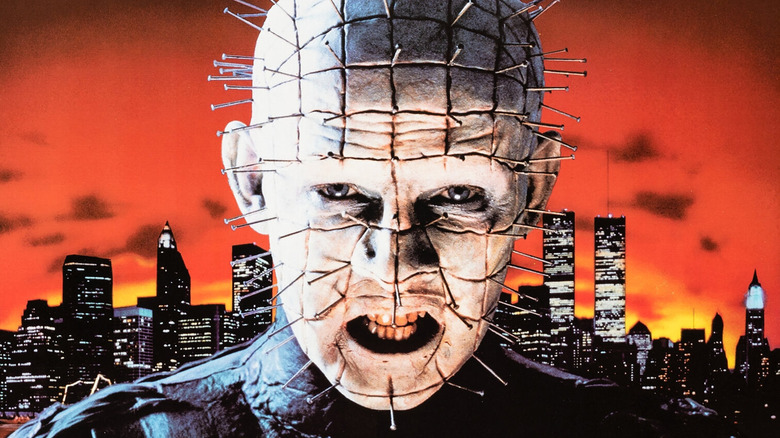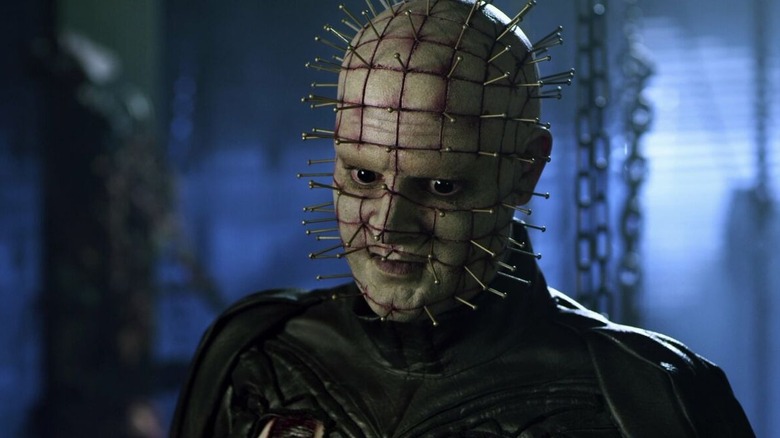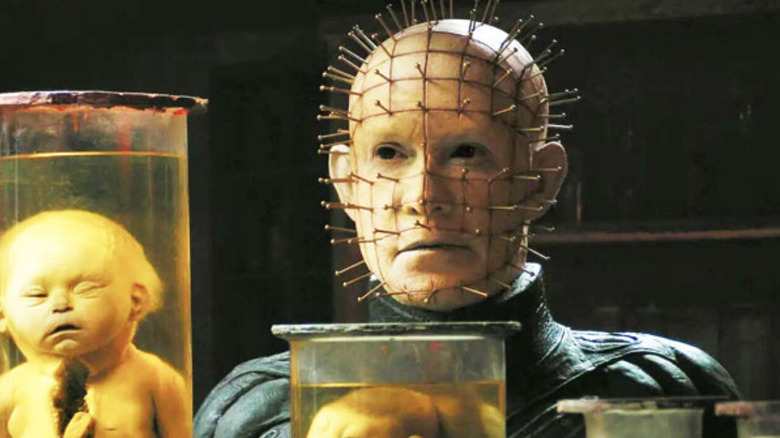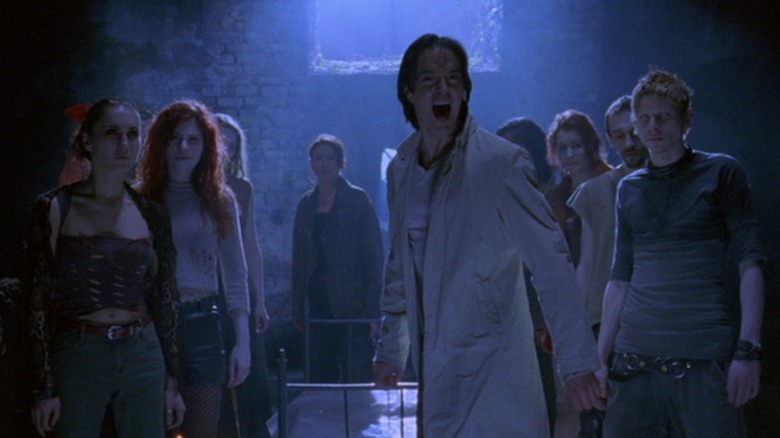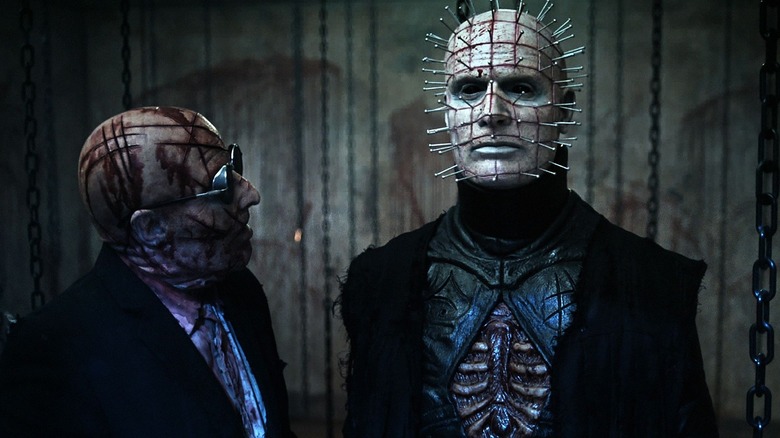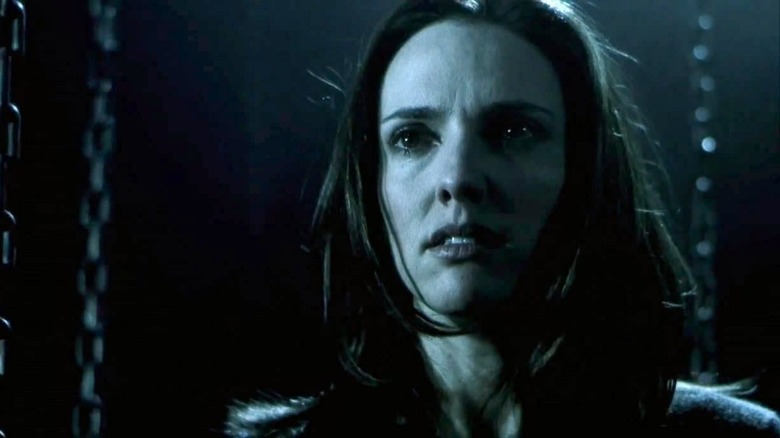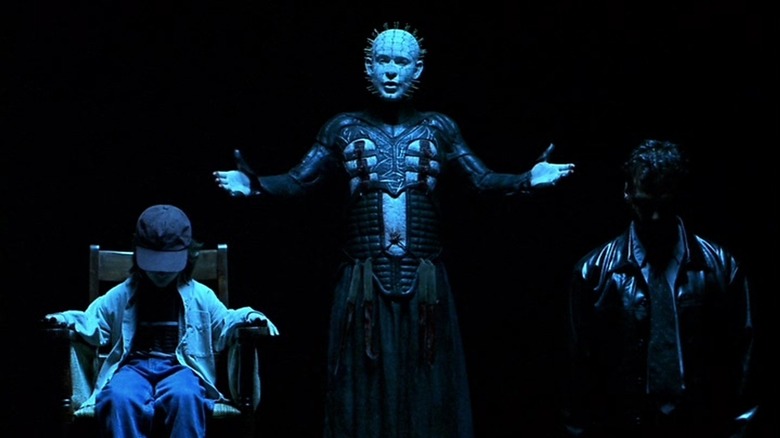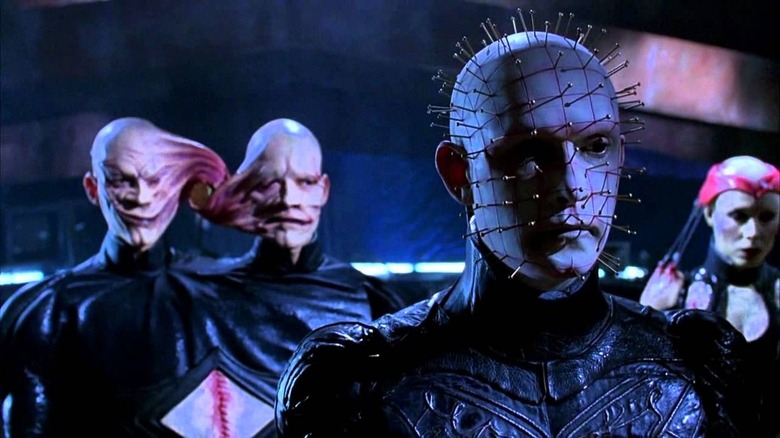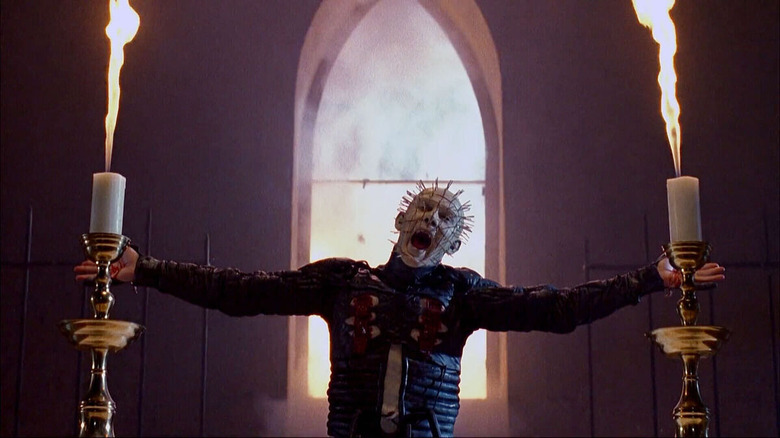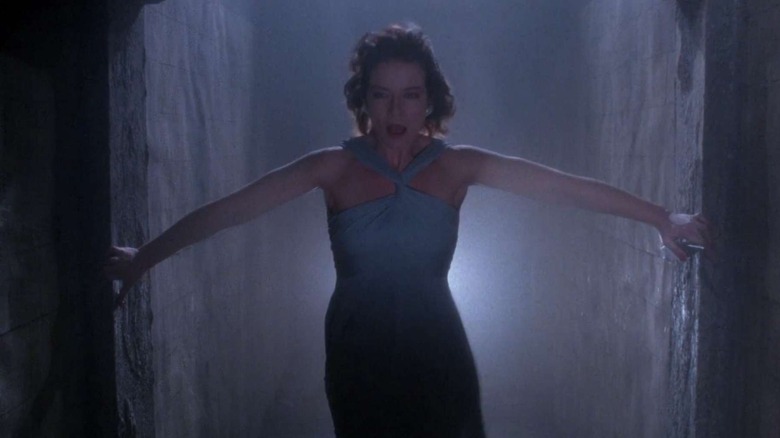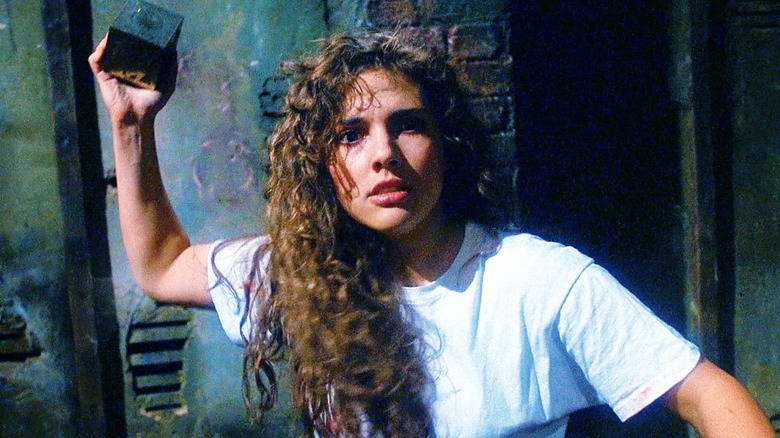Hellraiser Movies Ranked, From Pain To Pleasure
Clive Barker's "Hellraiser" series is one of the most recognizable franchises in modern horror history. The gothic horror saga that combined BDSM, queer subtext, and philosophical agony has proven to be a favorite with fans for decades.
In adapting his own novella, "The Hellbound Heart," Barker brought some much-needed freshness to horror in the 1980s at a time when the slasher villain ruled the roost. Centered on a mysterious puzzle box, the series revealed the demonic sado-masochistic forces of the Cenobites, a priest-like order of former humans who harvest souls for violent experiments. The head of these Cenobites, known as Pinhead, is one of the true icons of horror villainy. Freddy Krueger may offer great one-liners and Jason can slice you up good, but Pinhead is the one who gets into your head.
The "Hellraiser" franchise is a curious mish-mash of great ideas, ambition, studio meddling, and harried script rewrites. Like many a long-running horror series, it has its ups and downs, although "Hellraiser" has always had more low points than high. Mercifully, we're getting a new entry into the saga this month. Simply titled "Hellraiser", the new movie from Hulu seems to tick all the right boxes: it's R-rated, it's made by a genuine horror director with love for the story (David Bruckner), and Clive Barker is onboard as a producer. The trailer certainly got fans frothing at the mouth, with "Sense8" star Jamie Clayton now donning the pins to play our Hell Priest.
To celebrate the release of "Hellraiser", we're looking at the prior ten films in the franchise and ranking them from worst to best. Come, we have such sights to show you.
10. Hellraiser: Revelations
Fans knew this one was going to be bad when it was announced that Doug Bradley, who had played Pinhead since the first film, would not be returning for "Hellraiser: Revelations." It's almost impressive how shoddily made this film is, to the point where you almost wonder if it's secretly a parody of "Hellraiser" made by fans with no money. Even Barker took to Twitter to decry the film, saying that it is "NO F*****' CHILD OF MINE! I have NOTHING to do with the f*****' thing. If they claim it's from the mind of Clive Barker, it's a lie. It's not even from my butt-hole." Yikes.
Produced in a matter of weeks so that Dimension Films (formerly of Miramax and The Weinstein Company) could retain the series rights, "Hellraiser: Revelations" ended up playing in a single theater for a crew screening before going straight to DVD. And you can tell. The story, about two families whose sons went missing because of the puzzle box, is trite and poorly written. The acting is abysmal. The scares are non-existent. Poor Stephan Smith Collins, who has taken over as Pinhead, looks deeply uncomfortable in make-up that doesn't look finished. It's only 75 minutes long but feels never-ending. This is a film that exists for no reason beyond pure studio greed. Even hard-core "Hellraiser" fans should skip this one.
9. Hellraiser: Hellworld
You'll notice two recurring themes with the latter half of the "Hellraiser" franchise: one, the rush on behalf of Bob Weinstein's Dimension to push out a new movie solely to hold onto the property rights; and two, that the scripts started out as totally separate plots that someone was forced to shoehorn Pinhead and company into. "Hellraiser: Hellworld," released straight to DVD in 2005, started out life as an adaptation of a short story called "Dark Can't Breathe" by Joel Soisson. You get the sense that any horror franchise could have been clumsily shoved into this idea.
The set-up is at least intriguing: an MMORPG based on the "Hellraiser" series has engulfed the lives of six friends, one of whom became so obsessed that he apparently died by suicide to escape it. Two years later, they're invited to a private party for the game headed by the legendary Lance Henriksen, and soon, the Cenobites turn up to do what they do best.
Perhaps best known to some for featuring a young pre-Superman Henry Cavill, "Hellraiser: Hellworld" has some decent scares if you think of it as a generic slasher film. Of course, that's not what made "Hellraiser" so special, and as a "Hellraiser" movie, it's pretty bad. The meta aspect with the game could have built to something tricksy in the vein of the Cenobites' machinations, but it's all executed so sloppily. In fairness, it's hard to imagine how a hastily re-written script intended for entirely different purposes could have worked.
8. Hellraiser: Deader
Despite having maybe the worst title in the franchise, "Hellraiser: Deader" at least has some solid ideas propping up yet another speedily rewritten script for something that was initially Cenobite-free. Shot in Romania (a lot of these films were, for budgetary reasons), the story follows a dogged reporter as she journeys to Bucharest to investigate a Blair Witch-esque videotape that seems to show a cult committing ritualistic murder.
Bob Weinstein reportedly wanted the film to ape the tone and style of the ongoing Japanese horror trend from movies like "Pulse" and "Ringu", but it's hard to see any evidence of that in the finished product. Director Rick Bota was brought back behind the camera after making "Hellraiser: Hellseeker" but that film had better actors and some semblance of an actual "Hellraiser" story. Here, the problems bog down elements that would otherwise intrigue. Doug Bradley remains reliable and the idea of a cult eager to follow the Cenobites, who immediately laugh at their desperation, feels close to Barker's tone.
7. Hellraiser: Judgment
It's a real surprise that the 2017 addition to the franchise, which doesn't star Doug Bradley and bears the marks of yet another low-budget rush-job, ended up being surprisingly solid. It helps that the screenplay for this one, written by director Gary J. Tunnicliffe, was actually intended to be a "Hellraiser" film from the offset and not a forced rewrite of something unrelated.
Tunnicliffe himself, also on make-up duty, plays the Auditor, a clerk in Hell who is tasked with aiding the Cenobites in finding new ways to harvest souls in an era of advanced technology and decreased belief. This expansion of the mythos is truly fascinating and feels natural to Barker's world in a way few of the preceding films even attempted to be. This subplot gets bogged down with a more generic police procedural element that was done better in earlier films. Still, if the franchise had been able to continue down this route, fans wouldn't have been mad (the film was quietly dumped on VOD in 2018 after the sexual abuse allegations against Harvey Weinstein forced Dimension Films into a panic.) Horror nerds should look out for a supporting turn by "Nightmare on Elm Street" alumni Heather Langenkamp!
6. Hellraiser: Hellseeker
The sixth film in the series, "Hellraiser: Hellseeker," did the unthinkable and brought back Kirsty Cotton, the heroine of the first two movies. Granted, it's not the best use of one of horror's more underrated protagonists, but actress Ashley Laurence is putting in the work here and is always a welcome on-screen presence. "Hellseeker" sees Kirsty seemingly dead and missing following a car accident, and her husband Trevor (played by the ever-reliable Dean Winters) trying to find out the truth as he becomes a suspect in her murder.
You can't help but start grading these movies on a curve given the major downward trajectory since its origins, but there is at least something truly interesting about "Hellraiser: Hellseeker," both as a new installment of the series and as its own thing. Some sequences offer a more surreal visual experience than one would expect from this sort of budget — including one unnerving moment where the detective sees a murder happening through the eyepiece of a video camera, including changing angles, but he's filming an empty chair. Kirsty doesn't get the conclusion she deserves (in the comics, she becomes the new Pinhead and frankly, we were robbed of the chance to see Ashley Laurence in charge of the Cenobites), but it's still a satisfying ending to a story that feels more cohesive than what would follow. Its biggest problem is that it feels like a less striking version of the movie before it. Speaking of...
5. Hellraiser: Inferno
"Hellraiser: Inferno" has a lot going against it. The initial idea of having Kirsty face a plot by a cult to unleash the Leviathan and the Cenobites into the real world was nixed due to budget concerns. The script was, again, not intended to initially be for a "Hellraiser" film. And it had a first-time director behind the camera. Fortunately, said filmmaker is Scott Derrickson — best known today for "Sinister," "Doctor Strange," and "The Black Phone" — and you can see the origins of a sturdy horror director on display here.
At the very least, he understands that Pinhead is best utilized as a bystander to humanity's ills rather than a quippy slasher villain. The meat of the story is a morality tale wrapped up in a police procedural. An emotionally damaged detective with a history of cruelty and drug abuse is brought in to investigate what appears to be a ritual murder. He solves a puzzle box and then slowly his life starts to unravel. He's plagued by hallucinations and haunted by his own tumultuous past.
While all of the expected "Hellraiser" beats are here, what makes "Inferno" most effective is in how it utilizes Pinhead as a purveyor of psychological torture. Sure, chains and mutilation can get the job done, but what's more interesting than having your prisoner punish himself? Derrickson makes the most of a tiny budget and actor Craig Sheffer, who previously worked with Barker on his underrated fantasy horror "Nightbreed," gets some stand-out moments. If any of the maligned "Hellraiser" sequels deserve reconsideration, it's this one.
4. Hellraiser: Bloodline
It's a truth universally acknowledged that every long-running horror franchise must eventually end up in space. "Hellraiser" got there on its fourth try (take that, "Jason X"). Fans of the series often refer to this one as the last true "Hellraiser" film because it was the last one (until the upcoming Hulu reboot) to have Clive Barker shaping the script and its plot actually makes some cohesive sense with the preceding three movies.
It does have the dreaded Alan Smithee pseudonym attached in the director's credit, after Kevin Yagher wanted his name removed following Miramax's meddling with the production — which included cutting 25 minutes from the story, introducing Pinhead earlier than intended, and adding a happy ending. But even all of that idiotic micromanaging can't entirely quash the pure ambition that initially powered "Hellraiser: Bloodline."
Set across three points in time, "Bloodline" includes the creation of the original puzzle box in the 18th century (with none other than Adam Scott acting as a pervy antagonist), a descendant of the toymaker in the 20th century living in a skyscraper that resembles the box dealing with Pinhead, and a space station in 2127 awaiting the arrival of the Cenobites. Don't think too much about how some of this lines up with the major plot points of the third film and enjoy the pulpy madness. The origin story of the box makes for the most intriguing aspect of the film and offers an expansion of the mythology you can't help but yearn for more of. While "Hellraiser: Bloodline" is unfortunately messy, it's mercifully never boring.
3. Hellraiser III: Hell on Earth
With the third film, you could start to see the wheels fall off the franchise. It became clear that the radical aspects that made "Hellraiser" so fresh only a few years before were about to be intensely diluted with each passing installment. None of the human characters from the first two films are present (except for one brief video) and the sexual element that's key to the Cenobites' allure is gone. Yet what we have is still an intriguing series of ideas that offers a succinct conclusion to Pinhead's story and, if you choose to view it as such, a satisfying ending to a cinematic trilogy.
Following the events of the second film, Pinhead finds himself trapped in a statue called the Pillar of Souls, which finds its way to the office of a womanizing douchebag who quickly becomes Cenobite fodder. This Pinhead is utterly bereft of the slivers of humanity or calm distance he embodied in earlier films. Now split into two entities — including Captain Elliot Spencer, who later became a Cenobite — the film offers an often fascinating study of two halves of a broken man.
Would that the entire film was so inclined. Most of "Hell on Earth" gets kind of campy, with lots of fun new Cenobites including one comprised of CDs. There's a thematic reason this take on Pinhead goes full merciless slasher villain, but it feels like a harbinger of things to come in the franchise. Still, Doug Bradley totally steals the show in a dual role and those sillier parts are pretty fun, certainly more so than later installments.
2. Hellbound: Hellraiser 2
Released a mere year after the first film, "Hellbound: Hellraiser II" is a direct follow-up that keeps Kirsty as the hero as she's forced to take on an evil step-mother, a callous asylum doctor, and, of course, the gates of Hell itself. Stuck in a psychiatric hospital following the events of "Hellraiser," Kirsty is haunted by visions of her father being tortured in the underworld. Meanwhile, an ambitious psychiatrist hunts for the puzzle box and brings Julia Cotton, Kirsty's late stepmom, back from the dead to aid him in his hunt for pure pleasure. Needless to say, it does not go well.
"Hellbound" is a natural expansion of the first film but also a chance for Clive Barker (who didn't direct this time around, but did write the story) to flex his creative muscles. He might be best known as a horror writer but his greatest ambitions are revealed in his high-fantasy work (check out "Weaveworld" or "Imajica" for proof of that.) Here, we see the labyrinthine depths of Hell, which resembles a gothic version of an Escher painting. It's easily the most visually sumptuous of the franchise.
The origin story of Pinhead is laid out here in a shocking flashback that reveals the astonishing sacrifices required to be a Cenobite, but the true villain of the film is Julia. As played by the underrated Claire Higgins, Julia is the most dastardly and sexual take on the fairy-tale step-mother, with some '80s flair and a level of cunning that makes her seem far scarier than the ones with pins in their faces. Initially, the franchise was to center on her as the overarching villain. She tapped out after this film, which is a shame, but her arc remains one of the most satisfying parts of the entire "Hellraiser" world.
1. Hellraiser (1987)
Of course the original remains the best, and for good reason. Directed by Barker himself, "Hellraiser" is a tightly put-together horror that most potently captures the essence of the author's novella. The purest id of "Hellraiser" is here, that exploration of the malleable boundaries of pleasure and pain, and the depths some will sink to in order to achieve their most taboo desires.
A relatively faithful take on the novella, "Hellraiser" was infamously dismissed by Roger Ebert upon release with a half-star review that declared the film to be "as dreary a piece of goods as has masqueraded as horror in many a long, cold night." It's a strange description for a work that is certainly bleak in its moral outlook, but far more vibrant than such a description. It's often said that we're more scared of what we can't see than what we can see, but Barker makes sure the audience is just as petrified of what is shown in the harshest lighting available. The first true reveal of the Cenobites still ranks as one of the all-time great moments in '80s horror, and it's because you see every single detail of their astonishing make-up. The only scene that beats it is the extremely gooey reconstruction of the villain's body as it reverse-melts out of the floorboards!
While the Cenobites scare, the darkest and most effective part of "Hellraiser" is the humans, particularly its true antagonists, Frank and Julia. The former was torn apart by the Cenobites, while the latter kills unwitting souls to help him regain her lover's flesh. If you took out all of the inter-dimensional BDSM torture, you would still have an eerie and truly deviant tale of dark love gone horribly wrong. The Cenobites are mostly in the background here, truly acting as the clinical guards of obscenity that made them so upsetting in the first place. Even if we'd never gotten another "Hellraiser" film after this, it was clear from the get-go that we were seeing a genre masterpiece in the making.
